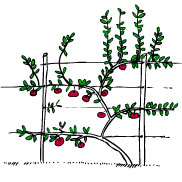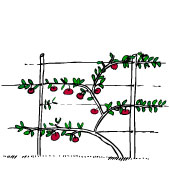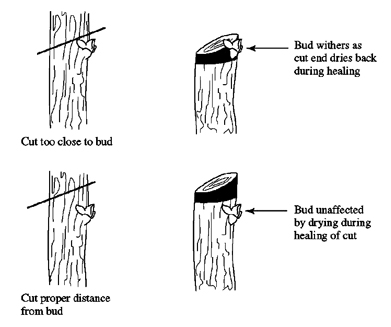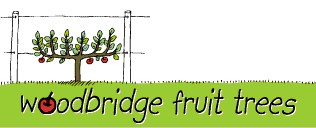No products
Pruning
Have a look at our Articles section. You'll find dedicated articles on summer pruning, espaliering and spanish bush pruning.
Pruning can be difficult to master. To some people, pruning a tree means hacking away at excessive growth. An orchardist, on the other hand will prune a tree to establish a strong frame-work: thin out secondary growth, let in more light to the centre of the tree, increase fruiting spurs, thin out or bend vertical branches (which grow leaves) and encourage horizontal branches (which produce fruit). Pruning also encourages a cycle of fruiting rather than a yearly cycle of producing growth in response to being hacked. Everyone has a different opinion about pruning so you'll have to read up and decide for yourself. Ultimately ask yourself the question - to what end am I pruning this tree?
 We find that the ideal time to prune dwarfing fruit trees is in summer as the fruit set. The shoots should have "hardened off" a bit - and take on the firmness and brittleness of maturing wood (not soft and green). This happens sometime in February - March depending on the seasons.
We find that the ideal time to prune dwarfing fruit trees is in summer as the fruit set. The shoots should have "hardened off" a bit - and take on the firmness and brittleness of maturing wood (not soft and green). This happens sometime in February - March depending on the seasons.
Pruning is easy if you are training onto an espalier. Prune off the tall vertical shoots coming off the horizontal branches on the wire, leaving a stub of 2-3 buds. Preserve one vertical shoot close to the main stem of the tree if needing to step up to the next wire, and same with the the outermost shoot to bend down to the existing wire level thus extending the width of the tree. One doesn't have to be completely strict with cutting back branches that are more horizontal - these can make the tree thicker and increase fruiting. Generally, vertical shoots produce leaves, while horizontal ones tend to produce fruit. By cutting away the tall new growth, you keep the shape of the espalier, allow light to fall onto developing fruit, encourages more flower buds to develop, prevents large root systems and encourages a fruiting cycle.
 After gently pruning the excess growth away, thin the apples to reduce the congestion. Where there are four or five in a cluster and you can see that they are pressing on each other, twist the unripe fruit (choose the blemished ones) off leaving 2-3. This gives the others room to grow, but don't overdo it!
After gently pruning the excess growth away, thin the apples to reduce the congestion. Where there are four or five in a cluster and you can see that they are pressing on each other, twist the unripe fruit (choose the blemished ones) off leaving 2-3. This gives the others room to grow, but don't overdo it!
When pruning, use sharp secateurs so to form a clean cut. Ragged cuts will allow water to pool and will make it more likely to admit infection. Cut at 45 degrees to the axis of the stem. If cutting larger branches, use a saw and try not to leave level surfaces that will collect water. When shaping the tree, select a healthy bud that is facing in the direction you would like a branch to shoot - often to the "outside" of the tree, then cut the stem at 45 degrees 4-5mm distal to the bud. Cutting it too close to the bud will dry it out and risk that bud dying.

